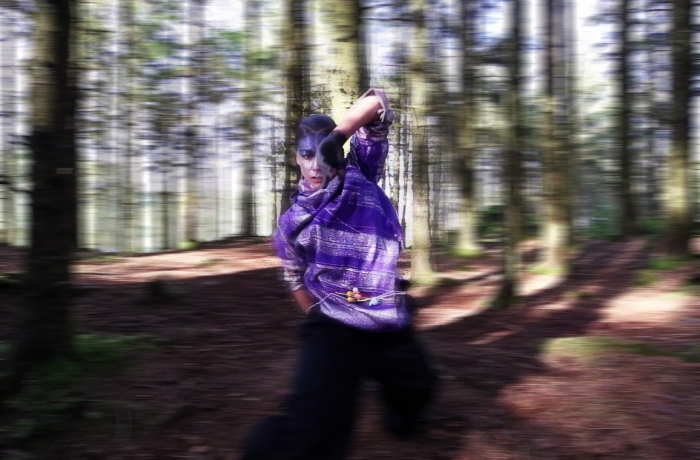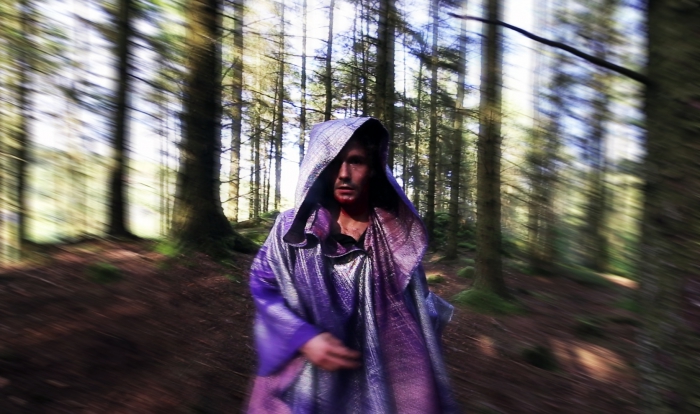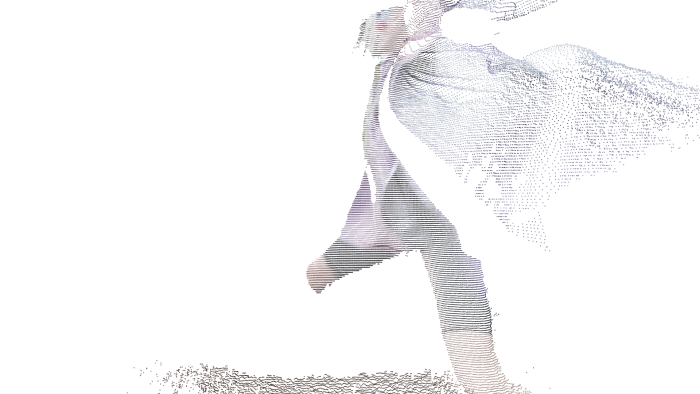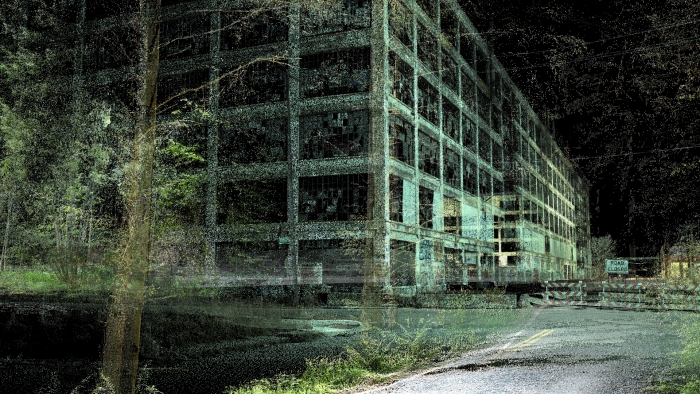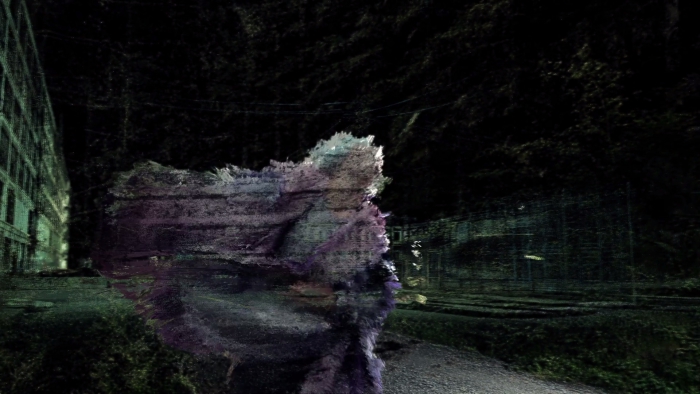The Model is the Map is the Territory
The Model is the Map is the Territory
George Kafka:
You’ve called Hello, City! a movie made entirely from data—what does that mean?
Liam Young:
Basically the film is a critique of the smart city. If the smart city works in the way that it’s supposed to, it’s all about data acquisition. It’s a city of sensor networks that collect as much information about everything as possible: weather, people, services, infrastructure. The smart city’s system stitches all these things together into this elaborate 1:1 model of the world and then makes decisions, like how much power to send to one place or when a bus should turn up. It takes over all the spontaneity and wonder of urban life in low-resolution algorithms that are only as good as the data that it collects. One of those key data collection networks is lidar, which is a cross between laser and radar. So Google’s driverless cars, for example, navigate the city using lidar to create an intricate 3D model and then they can decide, “that’s an old woman, I’m not going to hit that. That’s a street corner, I can turn there.” The laser scanner looks like a camera; it sits on a tripod and then it spins around shooting out a laser like a billion trillion times a second, which pings pack and creates a data point. This is basically the future of photography and the future of CCTV.
And this is how you made the film?
Yeah, instead of using real cameras we used lidar scanners. It’s the first movie to be shot entirely using lidar, so there is no image data at all in it. What you watch is information, data, xyz values. Essentially you can turn the entire movie into one giant excel spreadsheet, because a point consists of six numbers. You can literally just print that out as a six column excel spreadsheet…and I love that, that I could print out a book of numbers and that’s my movie! The film is trying to do is show how these machines see the city. We’re trying to turn the city into a character; you can have a first-person or third-person narrative, and we like the idea of first-person where the narrator is actually an autonomous machine city.
In this case the narrating city is Detroit—I was going to ask why Detroit is the central character, but actually you just said it: it’s the “machine city.” Considering its history as the “Motor City” and the effects of previous technological revolutions on its urban fabric, the choice makes total sense.
Detroit is a city defined now through technologies of automation. It has become more cost-effective to outsource automobile production to the automated production lines of China than to pay American laborers in Detroit to build the cars, so it’s a city that has collapsed and is shaped and defined by certain kinds of technology. It seemed right to retell a new form of narrative of automation within that context.
How does the story of the movie respond to life in the newly smart city?
The technologies kind of exist in parallel to the physical city. They don’t care about the physical aspects of the city as long as they can see through it, or go around it. But if you know the way they work and can fuck with them, then you can essentially change the data model of the city. And if everything is based on that data input then the model is the map is the territory—it doesn’t question its own parameters. So in the movie these guys develop a new architectural vocabulary that is designed to respond to the quirks of machine vision. For example, there’s an algorithm that Google uses to scan all the images in Google street view for faces, because for privacy reasons they have to blur them out. So if you made a building with the same proportions, light, shade, and tone as a face, you could create a building that blurs itself within Google street view. Machine vision isn’t neutral; it's full of biases and contradictions and complexities because machines are made by people essentially.
If you learn the biases of the algorithm, you can find ways to trick it and cheat it, and I think there is a new architectural logic of ornamentation that will emerge based around tweaking and tricking these systems—but also around making these systems work better. If anything the Detroit smart city will be stripped of a lot of its detail and complexity so it’s easier to process.
What is the performance element of the movie? Why have you chosen to present the project in this way, as a combination screening-performance?
It’s an immersive, audio-visual storytelling thing. I’m doing live narration, there’s a three-screen projection that I’m tweaking live; I’m playing with glitches and distortion live and Aneek [Thapar, a sonic artist and sound designer] is doing live mixing of the soundtrack, dialling things higher, lower, softer, glitchier, and distorting my voice as we go along. It’s somewhere in between an architecture lecture, a film, and a storytelling piece. And I guess it’s my form of trying to entertain myself, because I hate architects that get up and do architecture lectures. I call them the “shit-I-done lectures.”
Yeah, we had one of them from Rem Koolhaas in January…
Yeah you know how they go. They start off with a bunch of references to something they were looking at, maybe it’s a Renaissance painting or a news thing that just came out and then eventually they get around to some diagrams of a gallery they’ve just designed for a competition but then lost…it’s the only time they get to show the shit because it’s never going to be built, because they lost.
So not only is this an unusual format for an “architecture lecture” but, being at transmediale, I guess it’s not your typical audience either. It seems important to take this outside of the normal spaces for architectural debates as well.
Absolutely. The shit that Rem’s probably talking about is really important, he’s talking about cities and the futures of cities and how we should be responding to space differently, but the only people in the fucking room are architects and designers. We have so little scope of change within our discipline that to only talk to other people in the discipline is insane. I’m talking about distinctly architectural questions, but hopefully there are people in that room who are engaged because they also like listening to a story, because they also love listening to experimental ambient music, or they just like cool images thrown in front of them.
How do you envision people responding? Do you think there is a particular way to resist this dystopic vision of our future cities?
Hopefully these projects are forms of resistance. They’re trying to equip us with the tools to make informed decisions. The idea of a speculative project or great science fiction is that it’s not trying to predict some kind of future, it’s about looking in on the present in new ways in order to be able to make decisions. We’re so immersed in the familiar that we can’t see it right, but fiction creates this distancing lens that allows us to stand outside of the world that we’re in and look back in on it. So that process of critical assessment means we can go, hold your horses, this smart city shit is getting out of hand, lets actually think about what we want to be doing here.
George Kafka is a London-born, Berlin-based freelance writer and editor. @g_kafka
All images courtesy Liam Young.

